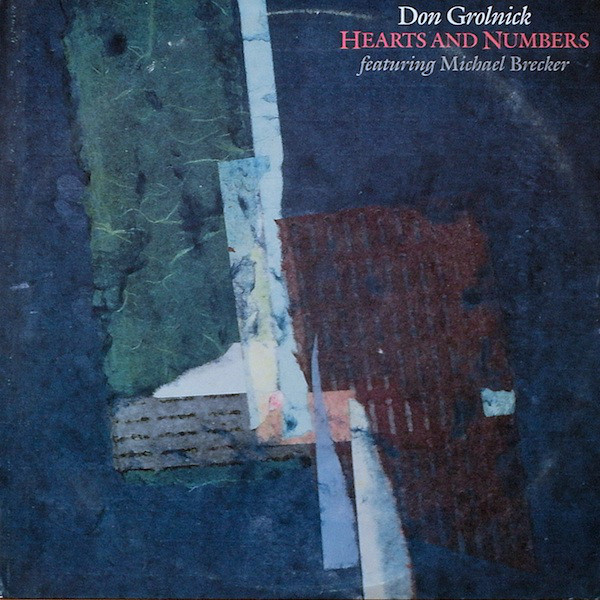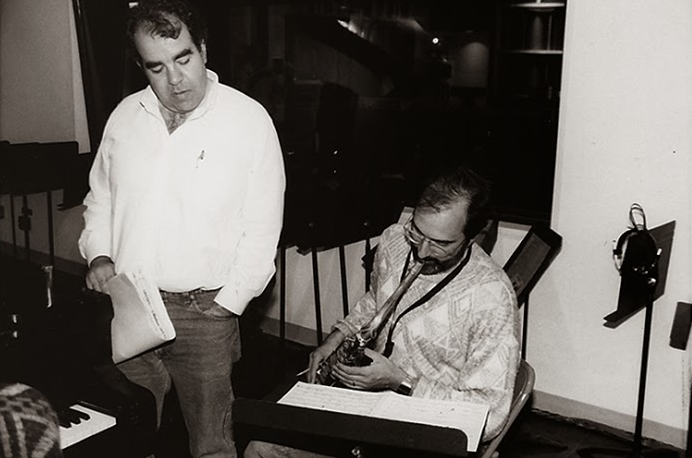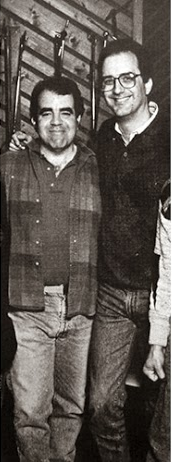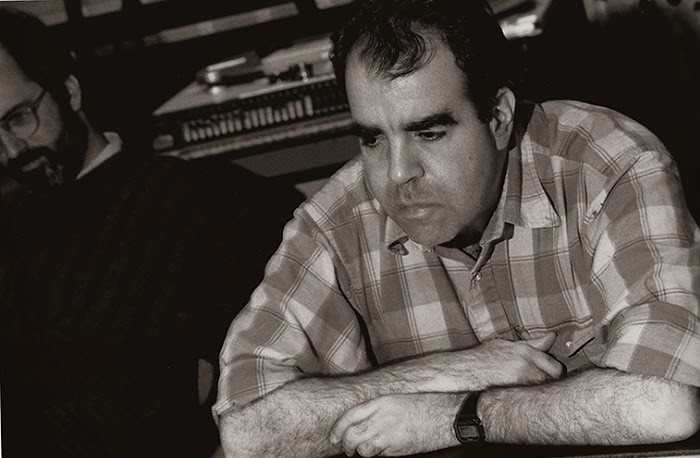Here’s another great Michael Brecker tenor sax solo transcription I am excited to share with everyone. This transcription has been available out there on the internet for many years now, so I have never posted my transcription here on my site, but I kind of wanted to now for sentimental reasons.
This transcription includes the chords which go with the solo which I haven’t seen out there on another transcription and there are some slight differences between mine and the one already available on the internet. The chords are from the Don Grolnick Collection which I purchased a few years ago when I was working on a transcription of “Four Chords” by Steps Ahead.
This is one of the first tenor sax solos I tried to transcribe my second year of college (I say “tried” because it was a weak and feeble attempt with so many wrong notes and messed up rhythms…..). I was going to Ithaca College at the time and this was one of the first Michael Brecker albums that I purchased. It is Don Grolnick’s “Hearts and Numbers” album and this solo is from the song “Act Natural”.
Don Grolnick Hearts and Numbers
I remember cranking this tune on my record player in my dorm room at Ithaca College and playing along with the record trying to sound as confident and “BA” as Michael Brecker did on the tenor saxophone. I had no idea what the chords were but I knew it was in E minor in that first section of the solo and I really played the tar out of that first 16 bars of the solo over and over again.
To be honest, I think I played bits of this solo on almost every E minor solo I took for the next 10 years! It still comes to mind almost every time I am playing in E minor because it is so ingrained in my brain (especially measures 9-11).
Don Grolnick-Act Natural-Michael Brecker Solo (Starts at 1:37)
This solo was a huge awakening for me because, although the tune sounded like it was in E minor (I am talking in the key for Bb tenor sax here, this would be D minor for concert instruments), Michael Brecker was playing lines from the B altered scale all over the place. The first 16 bars of this solo are really a great lesson in how you can play in an E minor tonality and use lines based off the E minor pentatonic (EGABDE), the E blues scale (EGABbBDE), the E dorian scale (EF#GABC#DE) and the B altered scale (BCDEbFGAB) to take things more “outside” the tonality (“outside” is a term that means playing lines that sound very dissonant against the harmony).
As I practiced to this song everyday, I really learned how you could use these four elements and mix them together to form a really interesting solo over a minor tonality. This was like my own personal lesson from Michael Brecker!
Michael Brecker and Don Grolnick in the 80’s
One of the most important lessons to be learned from Michael Brecker during these daily personal sessions with his recordings, was to play with an 80% sound. To fill the room with tone and to play with confidence! Michael Brecker played with such an authority and confidence, even if he played wrong notes, you would never know, because he played them so confidently!
I remember seeing him in person a year later in Buffalo NY with Steps Ahead, and he seemed so quiet and humble to me as he walked out and I watched him talking to the audience and interacting with the band. I thought “Is this the same guy I was listening to on the recordings?”
Michael Brecker and Don Grolnick in the 80’s
Then the music started and there was no question, Michael started playing his tenor saxophone and it was like he owned every corner of the room. When he took a sax solo, it was so commanding and powerful that you couldn’t turn away. I remember sitting in my seat and having so much excitement and energy that I felt like I couldn’t contain it! I didn’t know what it would take or even if I could ever do it but that was how I wanted to play!
Thanks again to Michael Brecker. The anniversary of his death passed a couple of weeks ago on January 13th. It’s hard to believe you have been gone for 14 years already. Your contributions to music and as a person are still having a lasting impact on those you interacted with and influenced as well as all those who have yet to hear your great recordings in the future. We miss you!
Michael Brecker and Don Grolnick listening intently……
I also want to acknowledge the great Don Grolnick whose album this was. Mr. Grolnick died in 1996 at the age of 48 from cancer. As I am now 53, 48 seems like such a young age to die. All I know of Don Grolnick is his incredible music, but I am so thankful for his creative brilliance and contributions to jazz. This album, “Hearts and Numbers” is one of the jazz classics for me and had a monumental impact on my musical life! Thank you Don Grolnick!
If you have any thoughts on Michael Brecker, Don Grolnick, the transcription or life in general, I would love to hear from you in the comments below. Steve
Act Natural-Michael Brecker Solo-Bb PDF
Act Natural-Michael Brecker Solo-C PDF
Act Natural-Michael Brecker Solo-Eb PDF
*If you would like to support me here at neffmusic.com, you can do so on the support page of my store by debit or credit card. Any support is appreciated and will go towards keeping this site running, saxophone reeds, mouthpiece patches, coffee, and towards justifying the many hours I spend on providing free transcriptions to the saxophone community! Thanks, Steve
If you like these type of outside modern sounding lines like I do, be sure to check out my Devastating Lines for Jazz and Funk Soloing for Minor and Dominant Grooves. These two books are filled with great modern 16th note lines in all 12 keys that you can learn and use while soloing. Check out all the 5 star reviews! Steve









Hey Steve, what exactly do you mean by ‘an 80% sound’? Thanks!!!
Just meaning when you play at 100% volume it is maxed out. That’s like full tilt all out. Sax players should practice playing at 80%. Big, full sound that fills every corner of the room. I was teaching for a few years and I noticed my students always seemed like they felt uncomfortable taking a solo and playing at full wailing volume. I asked them what volume they would say they practiced at and the majority of them said 30-50% volume. It hit me that when I practice, I practice at 80% because I want to be used to and prepared to play at that level when I take a solo. Ever since then I started teaching my students to practice at 80%. Practice like there is an auditorium full of a thousand people in front of you and you have no mic. That’s what it means to play at 80%…….
Right on, thanks for that! That made me realize that I actually play at 100% volume way too much of the time, that reduced the dynamic and emotional effect of what I’m trying to convey. I’m definitely striving for that golden 80%.
Yet another instance of the 80/20 distribution creeping up where we don’t expect it. Cheers!
Hi Steve , I really enjoyed your comments on this Don Grolnick album ! It’s for me (same as you) one of the beautiful album during this decade and still one of my best I could hear! There is a song that I specially love called “Four Sleepers” For me, Michael Brecker’s solo on this tune is one of his best, so creative, so inspiring, so sensitive …! We miss him for sure! Thanks for what you’re doing !!
Hi Steve, awesome, thanks!
As a learner, may I ask a question about the notation…
Measure 22 (under D13b9b5), 2nd beat, you notate a tied triplet for downbeat, then two 1/16ths.
Since in swung rhythm the 1/8th note downbeat is already considered to have the duration of the first two beats of a triplet, why not notate this more simply as 1/8th, then two 1/16s?
I don’t read a lot of double and quadruple time 1/16 and 1/32 lines, so maybe they are played straight and you wanted to emphasize this one measure is swung?
Thanks.
Warren, When I listened to that rhythm in measure 22 it sounded a to me like that triplet pulse from beat one continued through beat two to my ears. Triplets do not always imply a swung rhythm as this solo is a straight 16th note feel. On beat two I continues singing the triplets from beat one during that beat two held note and they seemed to line up with where the 16th notes come in to me. Hope that helps, Steve
Actually now that I listen back to it, if you listen to measure 21 in comparison to measure 22, I think it is more clear to hear. Measure 21 beats 2-3 I can clearly hear that 8th to 16th note rhythm. In measure 22 the F# and D# seem a little delayed and faster in speed than the 16th notes in measure 21. At least that is how I hear it.
Thanks, Steve, for your two detailed replies.
My take-home is the priority of listening, singing and playing along when reproducing an artist’s solo rather than slavishly forcing the performance into a system on paper—although you are an awesome notation transcriber and the notation clearly serves as a guide to learn the piece and memory aid when playing it.
Love all your materials and reviews.
Thanks, Warren
The reality is that the rhythm you asked about would be fine written either way. The difference between the two is miniscule. The bottom line for me is if I can read through the transcription and stay with the soloist note for note until the end. It might not be 100% perfect but if it is darn close and I can stay with the soloist I am transcribing that is the goal.
Thanks Steve for your writings about MB and transcriptions. I miss him too. Some of my jazz friends say “too many notes” but to me it’s pure passion, inspiring and infectious. I love Don Grolnick too and his song The Cost of Living is the saddest song ever. I heard Michael play it in concert here in Boulder, mentioning Don and his early death. Little did we know.
Thanks again
That part about playing 80% all the time is spot on. I too went to Ithaca College. I couldn’t crack the top Jazz Band so I asked Steve Brown why. He said, “I couldn’t hear ya, man!” Next round of auditions, I blew my guts out and I got in!
Now that I am a teacher, I feel like I spend the first year with my students saying “louder”, “more”, “bigger” over and over.
Haha! I can imagine Steve saying that with that accent of his. Yeah, 80% is what I tell students. Even as they are playing something. I’ll just yell out “80%” and immediately they start playing louder…. I also tell them to “fill the room with their sound” or sometimes to “aim their sound at the far corner ceiling of the room”.